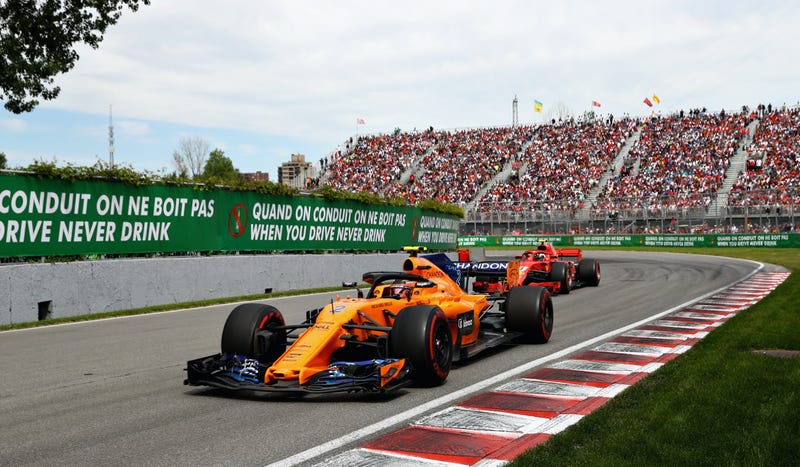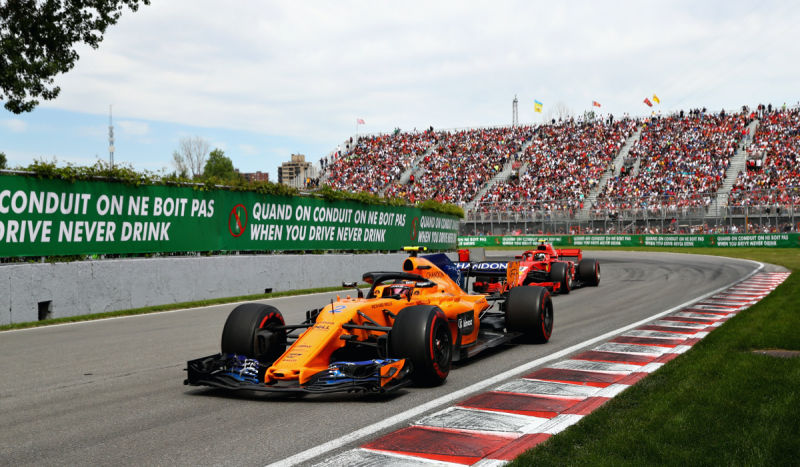
Have you ever seen those people on social media who somehow manage to go to an obscene amount of races each year? They’re not influencers or sponsors—they’re just regular race fans who somehow have managed to conquer all of the financial setbacks that have made sure you’ve only ever watched races from your couch. How the hell do they do it?
Cocaine smuggling? Basement fishery? Bitcoin mining? A monthly subscription offering home delivery of wine for owls? Theranos investing?
Advertisement
Miraculously, it’s none of these. Except maybe the owl thing.
I’ve been to at least five races a year since 2015. I did that all on my own dime as a full-time dual-degree college student without a full-time job. I was one of those kiddos who obsessively saved any money they stumbled across (totaling just over $4,000 by the time I graduated high school), then one of the lucky people who received a good scholarship to attend college. I tried to leave my childhood savings untouched in the bank account and never once used my scholarship money for anything but school, which meant my racing budget, grocery budget, and general Doing Stuff budget were all drawn from the same place: the extra $2,000 I was making a year from occasional freelancing, taking part in on-campus psych experiments, and, to a lesser extent, working for my family as they designed and built their escape-the-room game business.
I’ve seen Formula One and Formula E in Europe and IndyCar across North America. I’ve gone to IMSA, WEC, MotoGP, GRC, dirt track races, rallies, you name it. I still need to check NASCAR off my bucket list, but I can tell you this—I sure haven’t done any of these races from a VIP hospitality suite.
Advertisement
Through those experiences, I’ve found the most cost-effective ways to go to a race without feeling like you’re skimping on experience—and it’s time I share that with the world. This time around, we’re going to focus on the most important part of making sure you’re going to have an affordable trip: planning.
(Welcome to the Race Car Survival Guide, a new series where we outline all the tips and tricks that will help you make it through a race weekend intact. Whether you’re heading to your first race and are totally lost or are a veteran just checking out how other race fans do it, this is for you.)
Go In a Group
This is my number one tip. It’s imperative. Find a couple of people you wouldn’t mind spending time in close, probably drunken quarters with and recruit them for your race car adventure.
Advertisement
You’re not going to be able to cut every cost by grouping up, but you’re going to be more likely to have a great experience on a budget.
Here’s what I mean. This year at the Rolex 24, I was one of five people in a group who bought a trackside camping space. That sort of thing usually runs for around $400, but now suddenly sliced down to a mere $80 per person.
Another bonus: multiple people relieve some of the cost of travel supplies. If one friend brings a tent, another packs blankets, a third brings their blessed air mattress, and a fourth brings a cooler or a grill, you’ve just saved yourself the hassle of packing all those things yourself and the cost of having to buy anything you don’t already own.
Advertisement

If you don’t know any fellow race fans in real life—and we are a bunch of rare weirdos, so that’s understandable—the internet helps. I’ve never camped with anyone at a race who I did not meet on Twitter. Use your common sense and discretion here, obviously. Don’t trust someone who won’t let you mail them a Christmas card.
I flew to Europe for three races in 2015, and I’d never actually met the three other women I camped with before we all convened at the Munich airport—but I had all of their addresses and phone numbers and also knew the names of their siblings and pets.
Advertisement
Use your common sense. If you get bad vibes from someone, don’t plan travel with them. If they’re hesitant to share travel information, don’t travel with them. You should know as much about them as you would about a close friend. And for all my female race fans out there—traveling with a large group of women is generally your safest bet.
Plan Ahead
Like, really really far in advance. Like, a whole year.
It takes time to make plans. If you’re watching a race on TV and find yourself thinking “I want to be there next year,” then by all means start figuring out how to make it happen. The earlier you have a vague idea of what you want to do, the less money you’re going to spend, and the more friends you’ll be able to successfully convince to come with you.
Advertisement
Race tickets are usually cheapest right when they’re put on sale. AirBnBs are great to nab way ahead of time, before hosts realize there’s a big event happening and raise prices accordingly. Flights aren’t at their cheapest until about 53 days before you fly, but set up price alerts as soon as you can and sign up for airline mailing lists because they often run sales. It’s also far less stressful to, like, know what you’re doing two months before you do it.
Here’s what the beauty of a sale can do. The Canadian Grand Prix runs a Cyber Monday sale every year where you can get full-weekend tickets as cheap as $30. Yes, that is $30 for a full weekend of Formula One cars. Normally priced General Admission tickets are $112. And if you want to splurge on a grandstand, the cheapest will run you about $170.
You’re more likely to get more bang for your buck at IndyCar races. One of the most expensive weekends on the calendar is the Long Beach Grand Prix, and their GA tickets run at $95 with $147 getting you a reserved grandstand seat. That’s cheaper than the Canadian Grand Prix—and you also have the option to buy a paddock pass for a further $65, if you’re so inclined.
Advertisement
European F1 race weekend tickets run in the mid-$150s depending on the event—Silverstone, for example, is obscenely expensive while Austria is far cheaper. Formula E tickets have been selling for around $50 per race day—but prices climb as the series further establishes its legitimacy.
Certain races are affordable on the fly, but we’re talking, like, IndyCar at Pocono where you have a good chance of watching someone get helicoptered off to the hospital. If you’re going to, say, the Indy 500, the F1 US Grand Prix, or the Rolex 24, it’s best to have a game plan in place ASAP—tickets can run from $90 to $200 for single race-day tickets for those events, so it’s ideal to grab them when they’re at their cheapest.
Shop Sales
Sorry to all of you who refuse to hop on the trend, but you’re going to have to start shopping on our holiest of capitalism holidays, Black Friday and Cyber Monday, if you want cheap race tickets. Take comfort in the fact that you don’t have to get off your couch, and that you usually have multiple days to take advantage of a deal.
Advertisement
I’ve noticed that more and more North American tracks have been running Cyber Monday deals. If you want to go to the Canadian Grand Prix, for example, you can get general admission tickets for an entire weekend for around $30 USD. My friends: that is a steal! IndyCar races at St. Pete and Toronto run similar big discount sales.
Travel websites like Expedia also run really absurd sales during Cyber Monday—you just have to be very fast about clicking on them. I have not yet made these sales work for me, but I had a friend who secured 90 percent of his trip to the IndyCar Grand Prix at Toronto via Expedia, where he had a decent flight and a luxury hotel for about $100USD.
That’s why that whole “planning ahead” thing is great. Even if the race of your choice doesn’t end up running a sale, you’ll at least still be ahead of the game when it comes to making a purchase, and you’ll still get a cheaper ticket than the jamoke who waited until two weeks before the event.
Advertisement
And, at the very least, you can pick up your race supplies for a cheaper price. Do you need new luggage, a tent, better walking shoes, or a comfortable backpack? Well, friend, Black Friday is the time to stock up.
Do Your Research
Know the ins and outs of the location you’re traveling to. If you’re not staying at the track, does the track offer shuttles (and how much do they cost)? Are you going to need to use public transit, and how does it work where you’re going? Are there actual bathrooms with running water at the campsite? How much does a taxi or an Uber ride cost people on race day? Are there any convenience stores close to the track in case you need to grab something? What size bag do they allow, and can you bring your own alcohol into the track? How is post-race traffic? How early should you get to the track on race day morning if you’re in GA?
Advertisement
And make sure you know things like, say, what the baggage fees are for your chosen airline, if they charge you for a seat selection. What does your bank charge you in currency conversion fees—and would it be best if you paid with things in cash?
Most of these things are especially relevant for international travel, but it doesn’t hurt to know for domestic races, too. Life is going to be much smoother if you have a good idea of what to expect where you’re going, so you don’t end up with any huge unexpected expenses.
Other Things to Keep in Mind
The cheapest races are the ones out in the boonies that no one cares about. Why do I go to Pocono every year, despite the fact that I’ve watched drivers be airlifted out half the times I’ve been there? Because I can pull off a weekend for like $150, including camping, tickets, and pit/paddock passes. If your goal is less “go to the Indy 500″ and more “go to a race, generally” you’ll likely find the best deals at the tracks you wouldn’t put on your bucket list.
Advertisement
Price things out in anticipation of having to pay the most expensive average price for things. You will very likely find plenty of sales and good deals along the way, but if you can’t afford a worst-case scenario, it’s often good to rethink your plans. You don’t want to depend on getting everything at a discount only to find out that prices are increasing this year and now you’re all kinds of fucked.
Got any good ideas Race Car Survival Guide? If you have any tips of your own or an idea you’d like to see on the site, let us know in the comments or email me at ewerth [at] jalopnik [dot] com!













